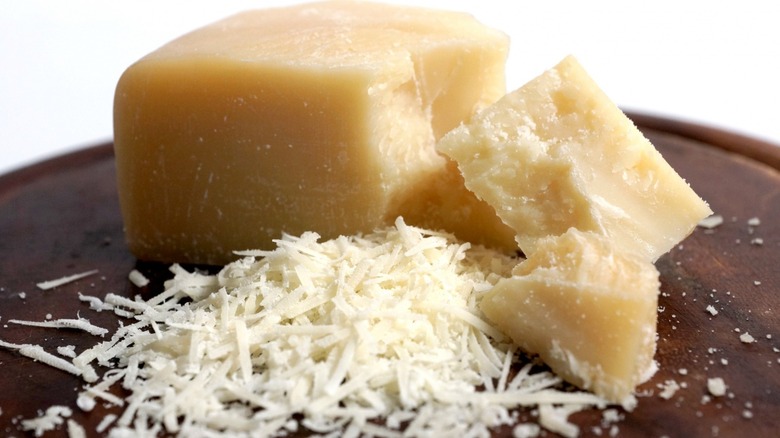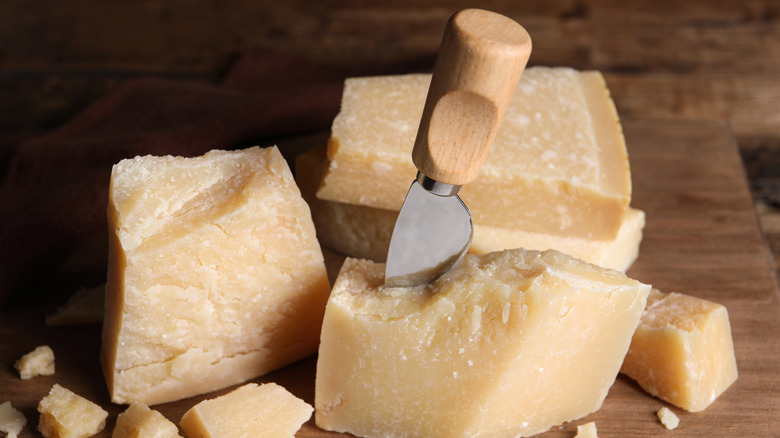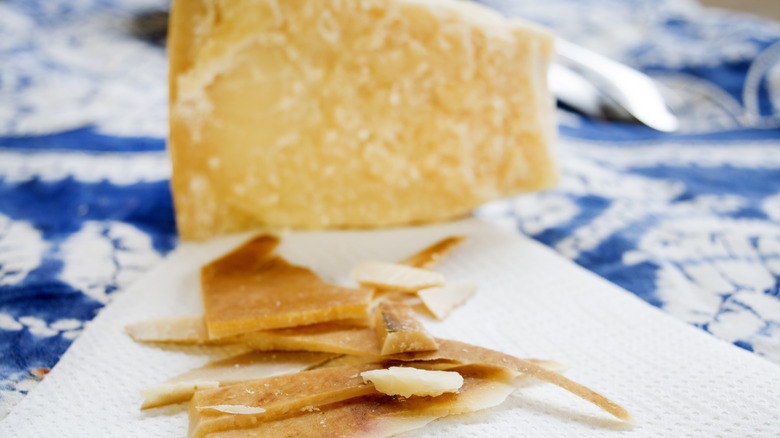The Biggest Mistakes You're Making With Parmesan Cheese, According To An Expert
If you only pull out the parmesan cheese when you need something to grate or shake over pasta, take it from us — you're missing out. There's a reason that Italian Parmigiano-Reggiano is called the "king of cheese."
Parmigiano-Reggiano from Italy is different from the American version of parmesan — and while they can both be delicious, it's easy to mix them up. Imitation parmesan rakes in almost as much money in annual sales as the officially name-protected cheese (via Food Navigator). To try to crack down on what they call fraud, the Parmigiano Reggiano Consortium is testing out a sci-fi solution: Food-safe tracking devices on the cheese rind label to verify you're getting the Parmigiano-Reggiano you're paying for.
From purchasing to cutting to storing, there are plenty of mistakes you should avoid if you want to treat Parmigiano-Reggiano like true cheese royalty. So to help reach parm perfection, Mashed consulted cheese authority Molly Browne, an American Cheese Society certified cheese professional and the education manager for Dairy Farmers of Wisconsin.
Why you might be cutting parmesan all wrong
When it comes to cutting popular cheese varieties the right way, cheesemongers recommend specific tools suited to the unique styles of cheese you're enjoying — so make sure you haven't chosen the wrong one. To carve your wedge of parmesan into snackable chunks, Browne recommends a sturdy, stocky knife-like one conveniently called parmesan knives or spade knives (via Wisconsin Cheese). "This gives the best control, which is important as parmesan is considered an 'extra-hard' cheese and therefore is more difficult to cut than softer cheese varieties," she told Mashed.
And if a wedge of parmesan cheese has been living in the back of your fridge for a while, it's not too late to cut into it — and you're not alone. "I should be embarrassed by how long I've kept some pieces of parm hanging around my fridge," Browne jokes. She tells Mashed that, for the most part, it's OK to trim off a moldy corner (what Browne calls "spots of rogue microflora") and use the rest of the cheese as normal. "Parmesan is internally ripened, so it's super clean and doesn't easily 'go bad,'" she says.
But the biggest blunder people make when it comes to parmesan comes down to a part of the cheese many might not even consider — the rind.
Stop wasting the cheese rinds
If you've cut or grated a wedge of parmesan cheese down to the rind and are preparing to chuck it, you're about to make another huge mistake. "Parmesan rinds are completely natural and full of flavor, so they can be repurposed in a variety of ways," Molly Browne tells Mashed.
Granted, there are some cheese rinds you shouldn't eat, like those made from wax or cloth — but parm rinds are fair game as long as they don't have a waxy coating. You already should be saving your parmesan rinds to add a salty, nutty depth of flavor to stocks, soups, and risottos (via Eataly). But Browne says you can go further by frying or chopping them to add crunch to salads. "I know some lucky dogs who regularly enjoy leftover parmesan rinds, and I have even heard of some people marinating them in olive oil and herbs for a tasty snack," she says. So by avoiding common mistakes people make with Parmigiano-Reggiano, you can not only save food but also make your meals more delicious!


